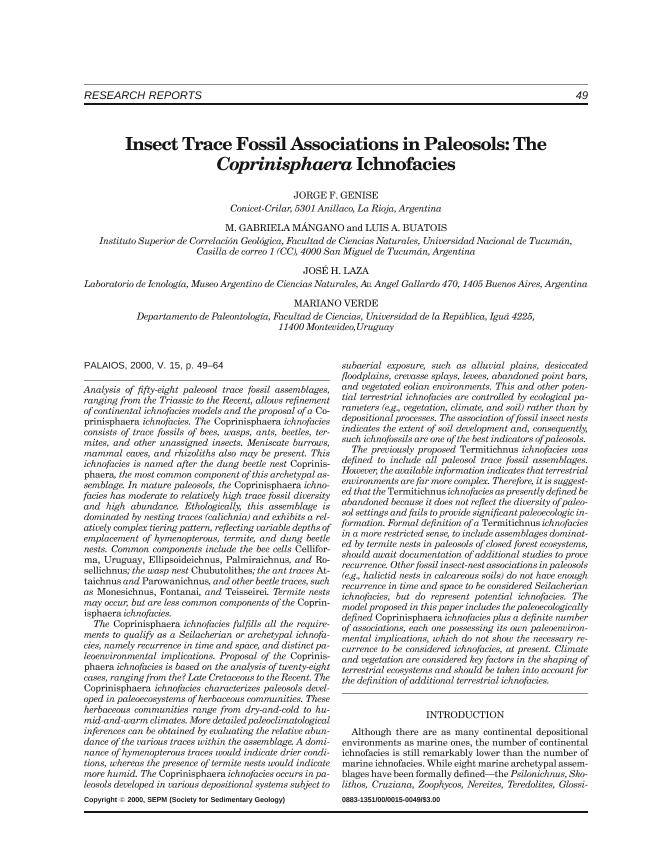Artículo
Insect Trace Fossil Associations in Paleosols: The Coprinisphaera Ichnofacies
Genise, Jorge Fernando ; Mangano, Maria Gabriela
; Mangano, Maria Gabriela ; Buatois, Luis Alberto
; Buatois, Luis Alberto ; Laza, José H.; Verde, Mariano
; Laza, José H.; Verde, Mariano
 ; Mangano, Maria Gabriela
; Mangano, Maria Gabriela ; Buatois, Luis Alberto
; Buatois, Luis Alberto ; Laza, José H.; Verde, Mariano
; Laza, José H.; Verde, Mariano
Fecha de publicación:
02/2000
Editorial:
Society for Sedimentary Geology
Revista:
Palaios
ISSN:
0883-1351
e-ISSN:
1938-5323
Idioma:
Inglés
Tipo de recurso:
Artículo publicado
Clasificación temática:
Resumen
Analysis of fifty-eight paleosol trace fossil assemblages, ranging from the Triassic to the Recent, allows refinement of continental ichnofacies models and the proposal of a Coprinisphaera ichnofacies. The Coprinisphaera ichnofacies consists of trace fossils of bees, wasps, ants, beetles, termites, and other unassigned insects. Meniscate burrows, mammal caves, and rhizoliths also may be present. This ichnofacies is named after the dung beetle nest Coprinisphaera, the most common component of this archetypal assemblage. In mature paleosols, the Coprinisphaera ichnofacies has moderate to relatively high trace fossil diversity and high abundance. Ethologically, this assemblage is dominated by nesting traces (calichnia) and exhibits a relatively complex tiering pattern, reflecting variable depths of emplacement of hymenopterous, termite, and dung beetle nests. Common components include the bee cells Celliforma, Uruguay, Ellipsoideichnus, Palmiraichnus, and Rosellichnus; the wasp nest Chubutolithes; the ant traces Attaichnus and Parowanichnus, and other beetle traces, such as Monesichnus, Fontanai, and Teisseirei. Termite nests may occur, but are less common components of the Coprinisphaera ichnofacies.
The Coprinisphaera ichnofacies fulfills all the requirements to qualify as a Seilacherian or archetypal ichnofacies, namely recurrence in time and space, and distinct paleoenvironmental implications. Proposal of the Coprinisphaera ichnofacies is based on the analysis of twenty-eight cases, ranging from the? Late Cretaceous to the Recent. The Coprinisphaera chnofacies characterizes paleosols developed in paleoecosystems of herbaceous communities. These herbaceous communities range from dry-and-cold to humid-and-warm climates. More detailed paleoclimatological inferences can be obtained by evaluating the relative abundance of the various traces within the assemblage. A dominance of hymenopterous traces would indicate drier conditions, whereas the presence of termite nests would indicate more humid. The Coprinisphaera ichnofacies occurs in paleosols developed in various depositional systems subject to subaerial exposure, such as alluvial plains, desiccated floodplains, crevasse splays, levees, abandoned point bars, and vegetated eolian environments. This and other potential terrestrial ichnofacies are controlled by ecological parameters (e.g., vegetation, climate, and soil) rather than by depositional processes. The association of fossil insect nests indicates the extent of soil development and, consequently, such ichnofossils are one of the best indicators of paleosols.
The previously proposed Termitichnus ichnofacies was defined to include all paleosol trace fossil assemblages. However, the available information indicates that terrestrial environments are far more complex. Therefore, it is suggested that the Termitichnus ichnofacies as presently defined be abandoned because it does not reflect the diversity of paleosol settings and fails to provide significant paleoecologic information. Formal definition of a Termitichnus ichnofacies in a more restricted sense, to include assemblages dominated by termite nests in paleosols of closed forest ecosystems, should await documentation of additional studies to prove recurrence. Other fossil insect-nest associations in paleosols (e.g., halictid nests in calcareous soils) do not have enough recurrence in time and space to be considered Seilacherian ichnofacies, but do represent potential ichnofacies. The model proposed in this paper includes the paleoecologically defined Coprinisphaera ichnofacies plus a definite number of associations, each one possessing its own paleoenvironmental implications, which do not show the necessary recurrence to be considered ichnofacies, at present. Climate and vegetation are considered key factors in the shaping of terrestrial ecosystems and should be taken into account for the definition of additional terrestrial ichnofacies.
Palabras clave:
Insect Trace Fossils
,
Associations
,
Coprinisphaera Ichnofacies
,
Paleosols
Archivos asociados
Licencia
Identificadores
Colecciones
Articulos(CCT-CENPAT)
Articulos de CTRO.CIENTIFICO TECNOL.CONICET - CENPAT
Articulos de CTRO.CIENTIFICO TECNOL.CONICET - CENPAT
Citación
Genise, Jorge Fernando; Mangano, Maria Gabriela; Buatois, Luis Alberto; Laza, José H.; Verde, Mariano; Insect Trace Fossil Associations in Paleosols: The Coprinisphaera Ichnofacies; Society for Sedimentary Geology; Palaios; 15; 1; 2-2000; 49-64
Compartir
Altmétricas



